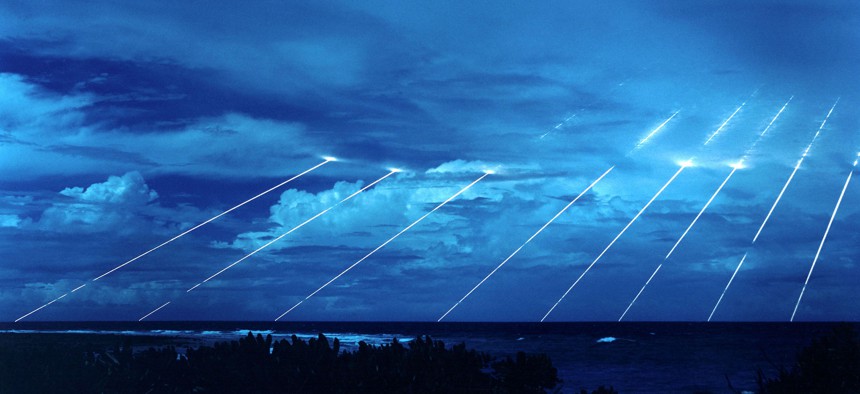
Among the weapons retired by the 2002 SORT agreement was the LGM-118A Peacekeeper missile, seen here being tested at the Kwajalein Atoll in the Marshall Islands. US Army
John Bolton Keeps Citing This 2002 Pact as an Arms-Control Model. It’s Really Not.
The Treaty of Moscow was ill-defined, unverifiable — and not something that Russia would sign today.
President Trump’s decision to withdraw from the 1987 Intermediate-range Nuclear Forces Treaty will leave only one agreement limiting U.S. and Russian nuclear forces: the 2010 New Strategic Arms Reduction Treaty (New START). Unfortunately, Mr. Trump does not appear to be a fan of this lone remaining pact, and his national security advisor, John Bolton, suggests the 2002 “Treaty of Moscow” model as an alternative.
That model, however, will go nowhere. The Russians would not agree. Moreover, it is not serious arms control.
New START, which limits the United States and Russia each to no more than 1,550 deployed strategic warheads and no more than 700 deployed strategic delivery vehicles, runs until 2021. It can be extended by up to five years, yet every time the topic of an extension arises, Mr. Bolton seems to prefer the Treaty of Moscow model.
When George W. Bush took office in 2001, Russia had just emerged from nine years of economic freefall. Starved of funds, Russian strategic forces were declining fast. They eventually fell to levels well below the 1,600 deployed strategic delivery vehicles and 6,000 attributed strategic warheads permitted by the 1991 START I Treaty.
No longer facing a rival superpower, the Bush administration’s nuclear posture review concluded that the United States could get by with 1,700 to 2,200 operationally deployed strategic warheads. President Bush suggested to President Vladimir Putin that they each simply declare their intended level of strategic warheads.
Mr. Putin desired a treaty. The Russians, with a still uncertain economic picture, especially compared to the U.S. economy, sought limits on U.S. strategic forces at levels below START I. A bilateral nuclear arms treaty also had political symbolism for the Kremlin, as it bestowed a semblance of superpower status.
Mr. Bush assented and signed with Mr. Putin the Treaty of Moscow—more properly called the Strategic Offensive Reductions Treaty (SORT). It required that the two countries each reduce to “no more than 1,700 to 2,200” operationally deployed strategic nuclear warheads by December 31, 2012, the day the treaty expired.
SORT was short, fitting neatly on two pages. One reason for its brevity: it contained no agreed definitions, no counting rules, and no monitoring measures. (In contrast, START I and New START each ran hundreds of pages in length.)
The Russians hoped for more, but they desperately wanted an agreement. Offered SORT essentially on a take-it-or-leave-it basis, Mr. Putin took it.
Could the United States negotiate something like SORT with Russia today? No. Already in 2008, Russian officials indicated that any future accord would have to limit strategic delivery vehicles as well as warheads.
Indeed, when the Obama administration began strategic negotiations with Moscow in 2009, Russian negotiators made clear that strategic delivery vehicles had to be limited. There is no reason to think that has changed today, particularly when the United States as of October 1 fielded 140 more deployed strategic delivery vehicles.
Jettisoning New START (or not extending it) in favor of a Treaty of Moscow/SORT-like agreement is a formula for a stalemated negotiation.
SORT, moreover, had severe shortcomings. With no definitions, counting rules or monitoring provisions, it was unverifiable. Each side was on the honor system to count its own warheads and keep that number below the limit.
Bush administration officials noted that START I remained in force until 2009, as did its monitoring provisions. However, START I monitoring provisions were ill-suited for monitoring SORT. For example, START I allowed inspectors to verify that a missile was carrying no more than a specified maximum number of warheads, not the actual number.
As it turns out, the United States and Russia may not have even counted the same things. The U.S. count included warheads on strategic ballistic missiles as well as bombs and air-launched cruise missiles stored at airbases for strategic bombers. (Neither side keeps weapons on bombers.)
It’s not clear the Russians included all those in their tally. Some believe Moscow only counted warheads on strategic missiles but not bomber weapons, since they were not physically on the bombers and thus not “operationally deployed.” We do not know, because SORT provided no way to check.
Mr. Trump’s decision to abandon the INF Treaty means that soon no caps will constrain land-based intermediate-range missiles. If Mr. Bolton’s suggestion of a SORT-like model prevails within Washington, that will mean a failed negotiation with Moscow and the end of limits on strategic nuclear forces. Given Mr. Bolton’s antipathy towards arms control, one has to wonder if that is his intention.
New START serves U.S. interests by capping Russian strategic arms with verifiable limits and provisions that give the United States a great deal of information about Russia’s strategic forces. It should be extended. Trying to replace it with sort of a treaty like the Moscow model would be foolish.




